
Edward Winter
A number of chess literature’s most famous games feature a king which wanders into the open, in most cases reluctantly. That fine writer W.H. Cozens (1911-1984) published a book entitled The King-Hunt, and T. Krabbé’s Chess Curiosities had a lengthy chapter on what he termed ‘Steel kings’. Here we examine some other, neglected examples from yesteryear, beginning with the most frequent type: enforced peregrinations. In the position below, the black king is smoked out by a violent combination prepared by an innocent-looking pawn move.

White to move (William Cook and William Henry Krause Pollock – Francis Joseph Lee and Oscar Conrad Müller, London, January 1888). White played 1 a3 and, after the routine reply 1...a5, unleashed 2 Nxe6 Kxe6 3 Qxd5+ Kxd5 4 Ba2 mate.
Source (position only): page 157 of Pollock Memories by F.F. Rowland (Dublin, 1899). In a lecture reported on page 14 of the January 1911 American Chess Bulletin Hermann Helms referred to this ending as ‘the acme of chess artistry’.
A similar ‘smoking out’ idea had occurred a few years earlier:
Reina – Thimm
Mexico City, circa 1884
Bishop’s Opening
1 e4 e5 2 Bc4 Nf6 3 d3 Bc5 4 Nf3 d6 5 O-O O-O 6 c3 c6 7 Bb3 Bg4 8 Be3 Na6 9 Nbd2 d5 10 h3 Bh5 11 g4 Nxg4 12 hxg4 Bxg4 13 Kg2 d4 14 cxd4 exd4 15 Bf4 Qf6 16 Kg3 h5 17 Rh1 Rfe8 18 Qg1 Nb4 19 Qf1 Kh7 20 a3

20...Nd5 21 exd5 Qxf4+ 22 Kxf4 Bd6+ 23 Kg5 f6+ 24 Kh4 Bf4 25 Ne4 Rxe4 26 dxe4 g5+ 27 Nxg5 fxg5 mate.

Source: Brooklyn Chess Chronicle, 15 June 1884, pages 137-138.
The next position, published on page 278 of the 31 July 1910 issue of Deutsches Wochenschach, also has knight and queen sacrifices on consecutive moves. The only details given are that White was Charles Kühne and that the game was played at the Geneva Chess Club:

White played 1 Qe2, and Black announced an elegant mate in four: 1…Ne5+ 2 fxe5 Qxe4+ 3 Kxe4 Bb7+ 4 Kf4 g5 mate.
It might be an exaggeration to call this game ‘Dufresne’s Evergreen’, but the finish is certainly piquant:
Jean
Dufresne – Willberg
Occasion?
King’s Gambit Accepted
1 e4 e5 2 f4 exf4 3 Nf3 g5 4 h4 g4 5 Ne5 h5 6 Bc4 Rh7 7 Nxf7 Rxf7 8 Bxf7+ Kxf7 9 d4 d6 10 Bxf4 Nd7 11 Bg5 Be7 12 O-O+ Kg6 13 e5 Bxg5 14 Qd3+ Kh6 15 Rf7 Ngf6 16 hxg5+ Kxg5 17 Rg7+ Kh4

18 Qh3+ gxh3 19 g3 mate.
Source: Deutsche Schachzeitung, August 1857, pages 267-268.
Next, two specimens in which the dragnet is set up by the move Qxg7+, followed by a powerful double check.

White to move (Vane – Miles, Sydney, 1897). 1 d5 Nxd5 2 Qxg7+ Kxg7 3 Be5+ Kh6 4 Bg7+ Kh5 5 Rxd5+ f5 6 Nf4+ Kh4 7 Rg4+ fxg4 8 Rh5 mate.
Source: Deutsches Wochenschach, 19 December 1897, page 467.
C.S.
Anderson – Schneider
Brooklyn, 1908
Hungarian Defence
1 e4 e5 2 Nf3 Nc6 3 Bc4 Be7 4 O-O Nf6 5 Nc3 d6 6 h3 O-O 7 d4 exd4 8 Nxd4 Bd7 9 Qd3 h6 10 Qg3 Kh7 (10...Nxd4 wins.) 11 Qd3 Kh8 12 b3 Nh7 13 f4 Na5 14 Bb2 Nxc4 15 bxc4 Qc8 16 Nd5 Qd8 17 Qg3 Bh4

18 Qxg7+ Kxg7 19 Nf5+ Kg6 20 Nxh4+ Qxh4 21 f5+ Bxf5 22 exf5+ Kh5 23 g4+ Qxg4+ 24 hxg4+ Kxg4 25 Rf4+ Kg3 26 Raf1 Ng5 27 Bd4 Nh3+ 28 Kh1 Nxf4 29 Rxf4 Resigns.
Source: American Chess Bulletin, September 1908, page 191.
‘A remarkable specimen of chess, particularly by correspondence’ was James Mason’s description of this game:
Lionel C. Moise – J.W.
Harriman
Correspondence game, 1899
Evans Gambit Declined
1 e4 e5 2 Nf3 Nc6 3 Bc4 Bc5 4 b4 Bb6 5 a4 a6 6 c3 Nf6 7 Qb3 O-O 8 d3 d6 9 a5 Ba7 10 Bg5 h6 11 h4 hxg5 (Mason gives this a question mark, suggesting instead 11...Qe7.) 12 hxg5 Ng4 13 Bxf7+ Rxf7 14 g6 Bxf2+ 15 Ke2 d5 16 gxf7+ Kxf7 17 exd5 Na7 18 Rh5 Qf6 19 Nbd2 Qf4 20 d6+ Be6 21 Ng5+ Kg6

22 Qxe6+ Kxh5 23 Rh1+ Bh4 24 Ngf3 Qe3+ (Here Mason recommends 24...g5.) 25 Kd1 Nf2+ 26 Kc2 Qxd3+ 27 Kb3 g5 28 Nxe5 Qxd6 29 g4+ Resigns.
Source: BCM, February 1900, pages 72-73.
Another novel game:
J.R. Deacon – Adrian Garcia Condé1 e4 Nc6 2 d4 d5 3 e5 Bf5 4 c3 e6 5 h3 Qd7 6 Nf3 O-O-O 7 Nh4 Be4 8 Nd2 Be7 9 Nxe4 dxe4 10 Qg4 Nxd4 11 Qxe4 Nb3 12 Be2 Nxc1 13 Nf3 Nxe2 14 Kxe2 Qb5+ 15 Ke3 Qxb2 16 Rhc1 Bc5+ 17 Kf4 Qxf2 18 Rc2 Rf8+ 19 Kg4 Nh6+ 20 Kh5 Qg3 21 Ng5 Rf5 22 h4

22…g6+ 23 Kxh6 Bf8 mate.
Source: BCM, February 1919, page 56.
And now an example from tournament praxis:
B.
Thanhofer – Emmrich
Oeynhausen, 14 August 1922
Sicilian
Defence
1 e4 c5 2 Nf3 e6 3 d4 cxd4 4 Nxd4 Nf6 5 Nc3 Bb4 6 Nb5 Nc6 7 Bg5 h6 8 Bh4 g5 9 Bg3 Nxe4 10 Nc7+ Ke7 11 Nxa8 Nxc3 12 bxc3 Bxc3+ 13 Ke2 Nd4+ 14 Kd3 Qa5 15 Be5 Qxe5 16 Kxc3 Nb5+ 17 Kb3 Qc3+ 18 Ka4 Qa3+ 19 Kxb5 d5 20 White resigns. (In view of the threatened 20...Bd7 mate or 20 Nb6 a6 mate.)

Source: tournament book, pages 168-169.
Sometimes an audacious king will, unprompted, commit felo de se. In the three examples below the king march is neither compulsory nor judicious:
A. Hvistendahl – James Stanley
Kipping
Liverpool v Manchester Team Match, Manchester, 17
November 1883
Giuoco Piano
1 e4 e5 2 Nf3 Nc6 3 Bc4 Bc5 4 c3 d6 5 d4 exd4 6 cxd4 Bb6 7 O-O Na5 8 Be2 Bd7 9 d5 Qf6 10 Bd3 c5 11 e5 dxe5 12 Nxe5 O-O-0 13 Nxd7 Rxd7 14 Qg4 g6 15 Bb5 Qe7 16 Bxd7+ Qxd7 17 Qxd7+ Kxd7 18 Nc3 Ne7 19 Ne4 Nxd5 20 Rd1 Kc6 21 b4 Nxb4 22 Rd6+ Kb5 (‘This was running his head into the noose indeed, but he may be forgiven on account of the pretty termination which it produces, and because in any case, with correct play, White must have won.’ – C.E. Ranken.) 23 a4+ Kc4
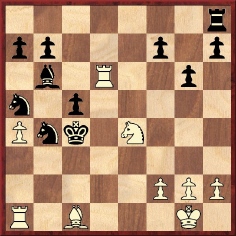
24 Bb2 Nb3 25 Bxh8 Nxa1 26 Nd2 mate.
Source: BCM, January 1884, page 20.
William Hewison Gunston – Oscar Conrad Müller
Manchester, 1890
Ruy López
1 e4 e5 2 Nf3 Nc6 3 Bb5 Nf6 4 O-O Nxe4 5 d4 Be7 6 Qe2 Nd6 7 Bxc6 bxc6 8 dxe5 Nb7 9 Nc3 Nc5 10 Nd4 Ba6 11 Qg4 Bxf1 12 Qxg7 Rf8 13 Kxf1 Ne6 14 Nf5 Bg5 15 Qxh7 Bxc1 16 Rxc1 Qg5 17 Re1 Qg6 18 Ne4 Qxh7 19 Nf6+ Kd8 20 Nxh7 Rh8 21 Nf6 Rxh2 22 Kg1 Rh8 23 Rd1 Nf8 24 Nd4 Kc8 25 Nf5 (‘Trying it on. Black’s king might have come back again. It is not clear what he hoped or expected by going to b7.’ – E. Freeborough.) 25...Kb7 26 Nxd7 Ne6 27 Nf6 Rad8 28 Rxd8 Rxd8 29 Ne3 Kb6 30 Kf1 Kc5 31 g3 Kd4 (‘The king is a strong piece and he plays boldly. The ending shows, in amusing fashion, how he may easily be too bold.’ – E. Freeborough.) 32 Nfg4 Ke4 33 Ke1 Ng5 34 Ke2 Rh8 35 c3 Rb8 36 b3 Rh8 37 f4 Nh3 38 Nf6 mate.

Source: BCM, November 1890, pages 456-457.
C. Schmid – C. Schwede
Dresden, 1879
Four Knights’ Game
(Notes abridged from James Mason’s)
1 e4 e5 2 Nf3 Nc6 3 Nc3 Nf6 4 Bb5 Bb4 5 Nd5 Bc5 6 d3 d6 7 Bg5 Bd7 8 Nh4 h6 9 Bxf6 gxf6 10 Qf3 Nd4 11 Bxd7+ Kxd7 12 Qg4+ Kc6 (‘If 12...Ke8, of course 13 Qg7. However, rather than undertake this ill-starred journey with his king, Black should interpose the pawn, and then, if 13 Nxf5 or 13 exf5, play 13...Qg5.’) 13 Nf5 (‘It would be safer to castle... 13...Nxf5 would defer the end, but make it certain – as certainties in chess are reckoned.’) 13...Nxc2+ 14 Kd2 Nxa1 15 Nfe7+ Kb5 16 a4+ Ka6 17 b4 Nb3+ 18 Kc3 Nd4 19 b5+ Ka5 20 Qd1 Re8 (‘Here Black perhaps misses his only chance. 20...c6 would give his antagonist a great deal of trouble – even if it would not compel him to raise the siege altogether.’)
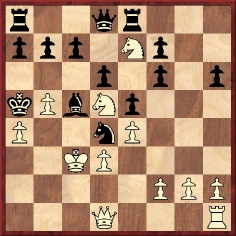
21 Kc4 Bb4 22 Nxb4 a6 23 Ned5 c5 24 Qd2 Resigns.
Source: BCM, May 1893, page 239.
There is some similarity between the preceding Schmid v Schwede game and this one:
Josef Rejfíř – Karel Treybal
Prague,
18 March 1928
Queen’s Gambit Declined
(Punctuation by Důras)
1 d4 Nf6 2 c4 e6 3 Nc3 d5 4 Bg5 Be7 5 e3 a6 6 cxd5 exd5 7 Bd3 Nbd7 8 Nge2 b6 9 Ng3 g6 10 Bh6!! Bb7 11 h4! c5 12 h5 c4 13 Bc2 b5 14 Bf4! Rg8 15 hxg6 hxg6 16 e4!! Nb6 17 e5! Nfd7 18 Qg4 Nf8 19 Nf5! Bc8 20 Qg3 Ne6 21 Be3 Kd7! 22 Nh6 Rf8 23 f4 Kc6 24 Ke2 b4 25 Na4
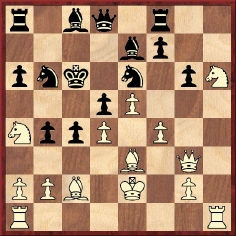
25...Kb5! 26 Nxb6 Qxb6 27 Rad1 Ng7 28 Qf3! Be6 29 g4 f5 30 gxf5 Nxf5 31 Nxf5 gxf5 32 Rh6! Rae8 33 Rdh1 Qc6 34 Rg6 Bd8 35 Rhh6 Qd7
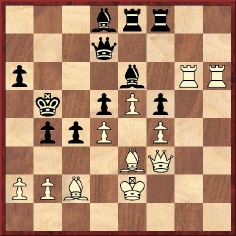
36 Qh1!! Bb6 37 Qd1!! Ka5 38 a3! b3 39 Bxb3! Qb5 40 Bd2+!! c3+ 41 Ke1! Bxd4 42 bxc3 Resigns.
Source: Československý Šach, April 1928, pages 54-55. Although Treybal lost, the game was also published on page 115 of the monograph Dr Karel Treybal by L. Prokeš (Prague, 1946).
Just occasionally, a centralized monarch can perform magnificently in the middle-game:
Alfred Crosskill – Edmund
Thorold
Beverley (England), 3 September 1875
Evans Gambit
Accepted
1 e4 e5 2 Nf3 Nc6 3 Bc4 Bc5 4 b4 Bxb4 5 c3 Bc5 6 O-O d6 7 d4 exd4 8 cxd4 Bb6 9 Nc3 Bg4 10 Bb5 Bxf3 11 gxf3 Kf8 12 Bxc6 bxc6 13 Kh1 Nf6 14 Bg5 h6 15 Bh4 g5 16 Bg3 h5 17 h3 Qd7 18 Kg2 Rg8 19 e5 Nd5 20 Nxd5 cxd5 21 Qd3 g4 22 hxg4 hxg4 23 f4 c5 24 dxc5 dxc5 25 Rad1 Rd8 26 f5 c4 27 Qa3+ Kg7 28 e6 fxe6 29 fxe6 Qb7 30 Be5+ Kg6 31 Qg3 d4+ 32 f3

32...Kf5 (‘This king is the most attacking piece on the board.’ – J. Wisker.) 33 Qf4+ Kxe6 34 Qf6+ Kd5 35 Bxd4 gxf3+ 36 Kf2 Rg2+ 37 Kxf3 Bxd4 38 Kxg2
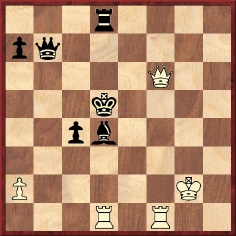
38...Kc5+ 39 Qf3 Rg8+ 40 Kh2 Qh7+ ‘and Black wins’.
Source: Chess Player’s Chronicle, October 1875, pages 337-338.
In the next example, the White allies miss their chance of a rare march:

White to move (Edersheim and Rudolf Johannes Loman – Censer and van’t Veer, The Hague, 14 May 1915). White played 25 Qxa7 and the game was eventually drawn. In the Amsterdam publication Weekblad A. Speyer pointed out that White could win easily and prettily by 25 Qc6+ Kf8 26 Qc8 Ke8 27 h4 (Preventing 27…g5, followed by 28…Rg6. If 27…g5 then 28 h5.) and the white king is free to infiltrate.
Source: Deutsche Schachzeitung, September 1915, page 269.
In the game below both kings have Wanderlust:
E.R. Perry – G.E.
Croy
Los Angeles, 1918
Queen’s Gambit Declined
1 d4 d5 2 c4 e6 3 Nc3 Nf6 4 Bf4 Nbd7 5 e3 c5 6 Nb5 e5 7 dxe5 Qa5+ 8 Ke2 dxc4 9 Nd6+ Bxd6 10 Qxd6 Ne4 11 Qd5 Qb4 12 Rb1 Nc3+ 13 bxc3 Qxb1 14 Qxc4 h5 15 e6 Qc2+ 16 Kf3 Nb6 17 exf7+ Kd8 18 Bg5+ Kd7 19 Qb5+ Kd6 20 Bf4+ Kd5 21 Bd3 Bg4+ 22 Kg3 (‘The kings do a merry dance around the board. For one player’s king to be at g3 and the other player’s at d5 with so much material remaining makes the position look more like a problem than an actual game.’)

22…Qxc3 23 Nf3 Bd7 24 Qb1 Qf6 25 Ng5 h4+ 26 Kf3 c4 27 Be4+ Kc5 28 a3 a5 29 Rd1 Rh5 30 Rd6 Bg4+ 31 Kxg4 Rxg5+ 32 Kf3 Nd5 33 Bxd5 and wins.
Source: BCM, September 1918, page 278. It was stated that ‘Master Croy’ was aged 15.
A complex game with underpromotion and a strange king march was given in C.N. 2353:
Häfner – L.
Herrmann
Dortmund, 1937
Nimzo-Indian
Defence
1 d4 Nf6 2 c4 e6 3 Nc3 Bb4 4 Qc2 Nc6 5 Nf3 d6 6 Bg5 h6 7 Bxf6 Qxf6 8 e3 O-O 9 Bd3 e5 10 d5 Nb8 11 O-O Bxc3 12 Qxc3 Qe7 13 Nd2 f5 14 f4 Nd7 15 Rae1 e4 16 Bc2 a5 17 Nb3 a4 18 Nd4 Nf6 19 b4 axb3 20 axb3 Bd7 21 Ra1 c5 22 dxc6 bxc6 23 b4 Kh7 24 h3 Nh5 25 Kh2 g5 26 Rxa8 Rxa8 27 g4 fxg4 28 fxg5 Qe5+ 29 Kg1 Qg3+ 30 Kh1 Qxh3+ 31 Kg1 Ng3 32 Rf7+ Kg8 33 Rg7+ Kh8 34 Rf7 Ra1+ 35 Qxa1 Qh1+ 36 Kf2 Qxa1 37 Rxd7 Nh5 38 Bxe4 g3+ 39 Ke2 Qb2+ 40 Kf3 g2 41 Ne6
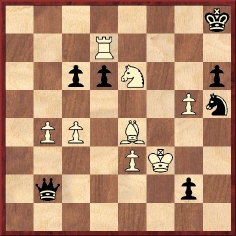
41…g1(N)+ 42 Kg4 Qe2+ 43 Kf5 Ng3+ 44 Kf6 Nxe4+ 45 Kg6 Nf6 46 gxf6 Qg4+ 47 Kf7 h5 48 Nf8 Nf3 49 Ke8 Ne5 50 Rh7+ Kg8 51 Rg7+ Qxg7 52 fxg7 h4 53 Nh7 h3 54 Nf6+ Kxg7 55 Nh5+ Kh6 56 Ng3 Drawn (although the endgame is a win for Black).
Source: Deutsche Schachblätter, 15 November 1937, pages 346-348.
The game between H. Colborne and Frederick William Womersley, Hastings, 1883 or 1884 (C.N. 2618) saw a most unusual march by the black king:

Play went: 72…Bf6 73 Be3 Kb4 74 Kf2 Kb5 75 Kg1 Kc6 76 Kf2 Kd7 77 Kg1 Ke8

78 Kf2 Kf7 79 Kg1 Kg6

80 Kf2 Bd5 81 Kg1 Be4 82 Ba2 b1(Q)+ 83 Bxb1 Bxb1 84 Bf2 Kf7 85 Ba7 Ke6 86 Bf2 Kd5 87 Ba7 Ke4 88 Kf2 Kd3 89 Be3 Bc3 90 Bb6 Kd2 91 Be3+ Kd1

92 Kg1 Ke2 93 Bb6 Be1 94 Bc5 Kf3 95 Bb6 Bxg3 96 hxg3 Kxg3 97 Bf2+ Kxf4 98 Kh2 Kf3 99 Bc5 f4 100 Bb6 Bf5 101 Bg1 g3+ 102 Kh1 Be4 103 Bb6 and Black mates in two.
Source: Brooklyn Chess Chronicle, 15 August 1884, page 168.
A game from page 632 of L’Echiquier, May 1927 was given in C.N. 2977:
P. Mendlewicz – Victor Soultanbéieff
Liège, 20 December 1926
Irregular Opening
1 e3 e5 2 b3 d5 3 Bb2 Nd7 4 Nf3 Bd6 5 c4 Ngf6 6 cxd5 Nxd5 7 Bc4 N5b6 8 O-O Nxc4 9 bxc4 e4 10 Nd4 Ne5 11 Nb5 Nf3+ 12 gxf3 Bxh2+ 13 Kxh2 Qh4+ 14 Kg1 Qg5+ 15 Kh2 Qh5+ 16 Kg3 Qh3+ 17 Kf4 Qh4+ 18 Ke5

18…c5 (Soultanbéieff gives this two exclamation marks.) 19 Nd6+ Ke7 20 Nxc8+ Raxc8 21 f4 Rhd8 22 Kxe4 f5+ 23 Kxf5 Rf8+ 24 Ke4 g5 25 Be5 gxf4 26 Rh1 Qg5 27 Rxh7+ Ke6 28 Qh5 Qg2+ 29 f3 Resigns.
Concerning 19…Ke7 Soultanbéieff writes:
‘This “logical” move loses the game, whereas the bolder 19…Kd8!!, which I indicated subsequently, leads to countless very beautiful variations and would have won by force.’
The diagram below shows the position after 19…Kd8:

Soultanbéieff now analysed eight White moves as leading to a win for Black, one example being 20 Nxf7+ Kc7 21 Nxh8 Qg5+ 22 Kxe4 Qf5 mate. A possibility not mentioned is 20 Kd5, and C.N. 2977 asked if Black also won after that move. In C.N. 2981 Karsten Müller (Hamburg) responded that after 20 Kd5 b6 Black does indeed win, as follows: 21 Nxc8 (Or 21 d3 Qe7, and if 21 Be5 Be6+ 22 Kc6 Qe7.) 21...Kxc8 22 f4 f5 23 Be5 Qe7.
By no means unknown, the game below, from C.N. 4123, is worth noting for a curious march by the black king, which strays as far as f4 and e4 but is back on its home square at the moment of victory:
Efim Dimitrijewitsch Bogoljubow – G. Bezručko
Kemeri-Riga, March 1939
Sicilian Defence
1 e4 c5 2 d4 cxd4 3 Qxd4 Nc6 4 Qe3 Nf6 5 Nc3 g6 6 Be2 d6 7 f4 Bg7 8 Nf3 Ng4 9 Qg1 f5 10 h3 Nf6 11 exf5 Bxf5 12 Nd4 O-O 13 Nxf5 gxf5 14 Be3 d5 15 O-O-O e6 16 g4 Ne4 17 gxf5 Nxc3 18 bxc3 Qa5 19 fxe6 d4 20 Rxd4 Kh8 21 Bc4 Qa3+ 22 Kd2 Na5

23 Qxg7+ Kxg7 24 Rd7+ Kf6 25 Bd4+ Kf5 26 Rd5+ Kxf4 27 Be3+ Ke4
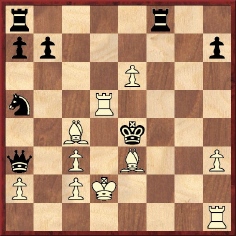
28 Rd4+ Ke5 29 Rd5+ Kf6 30 Bd4+ Ke7 31 Rd7+ Ke8 32 Bb5 a6 33 Rxb7+ axb5 34 White resigns.
Source: Šachs Latvijā by K. Bētiņš, A. Kalniņš and V. Petrovs (Riga, 1940), pages 265-266. The game also appeared, with detailed (languageless) notes on pages 229-230 of Bogoljubow – The Fate of a Chess Player by S. Soloviov (Sofia, 2004).
To the Chess Notes main page.
To the Archives for other feature articles.
Copyright 2007 Edward Winter. All rights reserved.